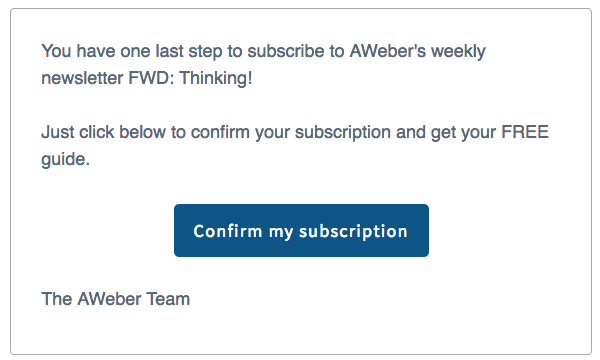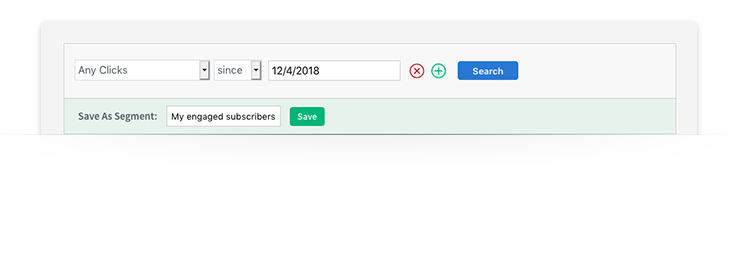
Step 1: Make sure you have permission.
It’s illegal to send emails to people who haven’t subscribed to your list. It’s also a great way to go to the spam folder. So, if your emails are going to spam, review your email lists to make sure all of your subscribers opted in to receive content from you. If you purchased one of your lists or all of your lists, delete those subscribers from your email marketing platform. They’re just hurting you. Plus, they didn’t give you permission to send them emails anyway, so they are much more likely to mark your emails as spam or not open them at all. If you’re not sure whether your lists are purchased, review subscribers to see how they joined. (You can see these details under Subscriber Management in AWeber.) Look for large lists of imported subscribers. Make sure you have a record of how you acquired these subscribers. Related: The Ugly Truth about Buying Email Lists Balle also recommends using confirmed opt-in (COI) emails for every new subscriber. A confirmed opt-in email is a message that’s automatically sent to people who fill out your sign up form. It asks them to confirm they want to join your list by clicking a link or button in the message. Internet service providers, like Gmail and Yahoo!, are more likely to deliver your emails to the inbox when you use COI emails. And on top of that, COI messages keep spam robots off your email list. Spam robots are automated computer programs designed to find sign up form code on your website and submit fake information to join your list. (Nobody wants a robot on their list. It’s difficult to tell them apart from real subscribers. And they decrease your open and click-through rates.) Related: Writing Confirmation and Welcome Emails People Love
Internet service providers, like Gmail and Yahoo!, are more likely to deliver your emails to the inbox when you use COI emails. And on top of that, COI messages keep spam robots off your email list. Spam robots are automated computer programs designed to find sign up form code on your website and submit fake information to join your list. (Nobody wants a robot on their list. It’s difficult to tell them apart from real subscribers. And they decrease your open and click-through rates.) Related: Writing Confirmation and Welcome Emails People Love
Step 2: Find the type of content your audience loves.
Often, your email reputation is damaged because your subscribers aren’t engaging with your emails. If your open rates are below 15% and your click-through rates are below 5%, you’re in the danger zone, says Balle. To rebuild your email reputation, you need to boost your open and click-through rates. There’s a simple way to accomplish this: Send content your audience can’t wait to open and read. Take a look at the emails you’ve sent in the past, says Balle. Are there certain messages that earned more opens and clicks? If so, you should send more content like this! Jot down a list of related (but new) content ideas for future emails. Related: 8 Top Brainstorming Techniques to Help You Write Killer Emails You can also ask your subscribers what kind of content they’d like to get from you. Simply send them a brief email asking what questions they have. Once you know what kind of content interests your audience, draft a few emails around those topics. We’ll use these messages in step 4! Related: 18 Tried-And-True Ways to Improve Your Email ContentStep 3: Build a segment of your most-engaged subscribers.
Using your email marketing platform, build a segment of subscribers who have clicked a link in one of your emails in the last 3 months. This is your most engaged group of subscribers. They are more likely to open and click future emails. You’ll use this segment of people to begin rebuilding your email reputation with internet service providers. With a good email reputation, more of your emails will reach the inbox! Related: How to Create a Segment in AWeber
This is your most engaged group of subscribers. They are more likely to open and click future emails. You’ll use this segment of people to begin rebuilding your email reputation with internet service providers. With a good email reputation, more of your emails will reach the inbox! Related: How to Create a Segment in AWeber
Step 4: Send value-packed emails to your segmented audience.
For the next 2 weeks, focus on sending high-value emails to the audience you identified in step 3. Aim to send 1 to 2 emails each week. Use the messages you drafted in step 2! Make sure that your audience likes the content you’re sending. High open and click-through rates and low spam complaints are a good indicator that they do. But fair warning: You won’t see high rates right away. When recovering from spam folder placement, your open and click-through rates will start low, according to Balle. “You want to make sure that those metrics are increasing. Many companies give up too early during this step. It will be around two weeks when you really start to see a difference,” she says. Once your open rates are above 15% and your click-through rates are above 5% with your engaged segment, start gradually increasing your segment size. Add people to your segment who clicked an email in the last 4 months. As you send emails to this larger segment, watch your open rates and your click-through rates for about a week. If they hold steady, then add people who clicked an email in the last 5 months. Watch your open rates and click-through rates again. Keep going until you’re sending to people who clicked your emails in the last 12 months. One of the biggest mistakes Balle sees is adding people to your segment too quickly. Each time you add more people to your segment, make sure you don’t increase your segment by more than 50%. For example, let's say you have a list of 10,000 engaged subscribers. When you increase your segment size, add 5,000 subscribers or less. Send for about a week. Then, add the next segment. And if you add a new segment and you can’t increase your open and click-through rates, stop adding new segments. Move on to step 5. Related: The 7 Questions Everyone Has about Email List SegmentationStep 5: Create a re-engagement campaign for unengaged subscribers.
Now, it’s time to try to re-engage subscribers who aren’t opening and clicking your emails with a re-engagement campaign. A re-engagement campaign is a group of emails that asks people to confirm they actually want to be on your email list. For your re-engagement campaign, build a segment of people who haven’t clicked on a link in your email for the last 12 months or at the point where you could no longer increase your opens and clicks. The segment size for this re-engagement campaign should be no more than 10% the size of your newly engaged list. If it’s larger, it could sabotage the work you’ve done so far with your engaged segment. So if you have a list of 10,000 subscribers who have recently clicked a link in one of your emails, your engagement campaign should only include 1,000 people. You may need to send multiple engagement campaigns to cover all of your less-engaged customers. Once you build your segment, send a re-engagement campaign to them. Send one email. Wait 7 days. Then, send one more. Don’t send a third. According to Balle, a third re-engagement email often ends up in the spam folder. Related: How to Win Back Subscribers with a Re-Engagement Campaign If you have subscribers who haven’t opened or clicked an email in more than a year, you might want to consider excluding them from your re-engagement campaign. They are less likely to re-engage, and they may sabotage your re-engagement campaign by decreasing subscriber engagement.Step 6: Delete subscribers who don’t re-engage.
If a subscriber doesn’t re-engage or hasn’t opened an email in years, it’s time to delete them. They’re just hurting your email deliverability and your bottom line. Related: How to Delete Unengaged SubscribersStick to the plan. Reach the inbox.
Improving your email reputation takes time and patience. But by following this plan, you can increase your chances of reaching the inbox and build a healthy email list of people who want your emails! Want to use an email marketing platform that helps more people reach the inbox? Create a free account with AWeber.The post The 6-Step Plan to Escape the Spam Folder appeared first on Email Marketing Tips.
from Email Marketing Tips http://bit.ly/2BfdYYn



No comments:
Post a Comment